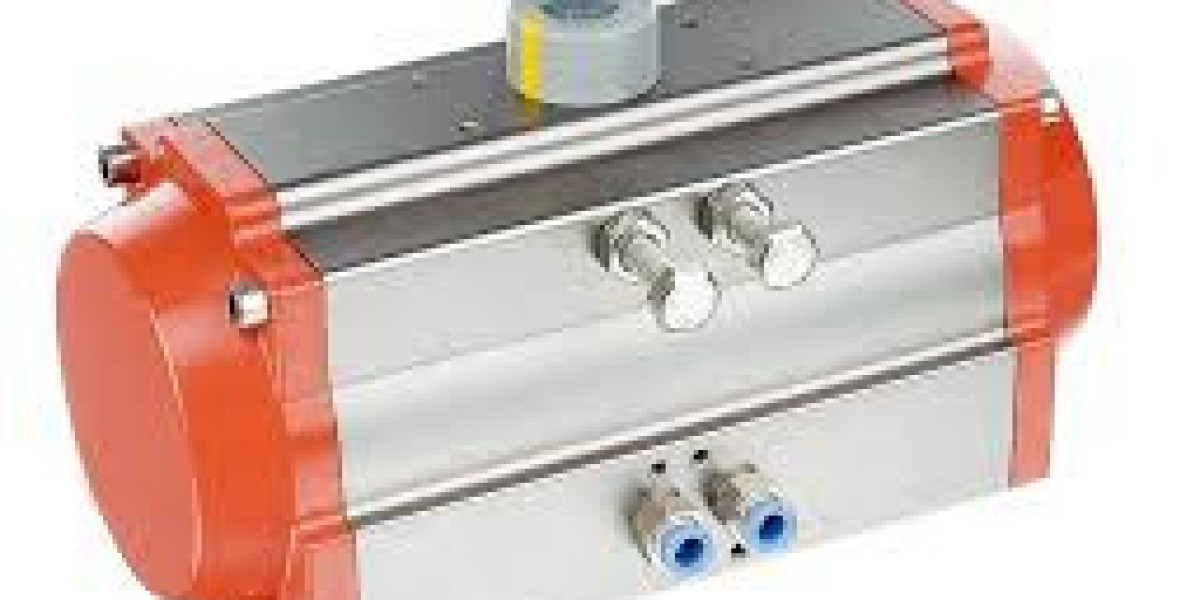n modern industrial systems, the demand for speed, reliability, and automation has made pneumatic valve actuators an essential solution for controlling fluid and gas flow. These devices use compressed air to operate valves automatically, offering quick response times and high torque output—perfect for high-cycle applications and harsh environments.
Whether used with ball valves, butterfly valves, or other quarter-turn valves, pneumatic actuators are ideal for industries like oil and gas, water treatment, power generation, and chemical processing. Their rugged design and adaptability make them a popular choice for engineers and plant operators seeking efficient and powerful valve automation.
What Is a Pneumatic Valve Actuator?
A pneumatic valve actuator is a device that converts compressed air energy into mechanical motion to operate a valve. Most commonly used with rotary valves (such as ball and butterfly valves), the actuator turns the valve open or closed—or holds it at a specific position—based on control signals from an automation system.
Unlike electric actuators, which use motors, pneumatic actuators use air pressure to generate movement, making them faster and often more reliable in extreme or hazardous environments.
How Pneumatic Actuators Work
Pneumatic actuators operate using a supply of compressed air, usually ranging from 4 to 8 bar (60 to 120 psi). When the air enters the actuator chamber, it pushes a piston or diaphragm, which then rotates or moves a shaft connected to the valve.
There are two main operating types:
Single-acting (spring-return): Uses air pressure to move the valve in one direction; a spring returns it to the original position when air is removed.
Double-acting: Uses air pressure to move the valve in both directions—open and close—without a spring.
Each type has its advantages depending on the application, safety requirements, and available air supply.
Types of Pneumatic Actuators
1. Rack and Pinion Actuators
These are the most common for quarter-turn valves. Two pistons move linearly inside a cylinder, turning a central pinion gear connected to the valve stem. They offer a balanced torque output and are compact in design.
2. Scotch Yoke Actuators
These actuators provide higher torque output at the beginning and end of the stroke, where valves often need more force. They're typically used for large valves or those with high friction.
3. Diaphragm Actuators
Used mostly in linear valve applications like globe valves, these actuators use air to press against a flexible diaphragm, moving the valve stem vertically.
4. Rotary Vane Actuators
Designed for precise rotary motion, vane actuators are compact and suitable for low-torque applications requiring frequent cycling.
Benefits of Pneumatic Valve Actuators
Fast Operation
Pneumatic actuators provide quick opening and closing, ideal for emergency shutoff applications or high-speed processes.
High Torque Output
These actuators can deliver significant torque, making them suitable for large or tight-sealing valves like high-pressure ball or butterfly valves.
Durability and Reliability
Pneumatic systems are less susceptible to overheating, electrical failure, or overload, and they work well in harsh or hazardous environments.
Simple Design and Maintenance
With fewer electrical components, pneumatic actuators are easier to maintain and troubleshoot, especially in field operations.
Fail-Safe Capability
Spring-return models can be designed to fail open or fail closed in the event of air supply loss, ensuring system safety during power failures.
Applications of Pneumatic Valve Actuators
Oil and Gas Industry
Used for wellhead control, pipeline management, and gas distribution systems, especially where explosion-proof systems are required.
Water and Wastewater Treatment
Automating valve operation in filtration, pumping, and chemical dosing systems where fast and reliable control is essential.
Chemical and Petrochemical Plants
Ideal for handling aggressive or hazardous fluids, where remote automation and safety control are critical.
Power Generation
Used in steam and cooling systems for rapid valve actuation, especially in turbine bypass and safety-related applications.
Food and Beverage
Pneumatic actuators ensure hygienic valve control in clean-in-place (CIP) systems and automated processing lines.
Control Options and Accessories
To maximize the functionality of pneumatic actuators, several accessories and control options are available:
Solenoid Valves: Control the air supply to the actuator using electrical signals from a PLC or control panel.
Positioners: Allow modulating control for proportional valve positioning, improving precision in flow control applications.
Limit Switches: Indicate the open or closed status of the valve for feedback to a control system.
Air Filter Regulators: Ensure clean, dry, and regulated air reaches the actuator for reliable performance.
Manual Overrides: Allow manual operation during power or system failures for maintenance or emergency operation.
Pneumatic vs. Electric Actuators
While both types have their advantages, pneumatic actuators excel in certain conditions:
| Feature | Pneumatic Actuators | Electric Actuators |
|---|---|---|
| Speed | Fast | Slower |
| Torque Output | High | Moderate to high |
| Hazardous Environments | Explosion-safe | Requires additional protection |
| Maintenance | Simple, mechanical | More complex |
| Energy Source | Compressed air | Electrical power |
| Cost | Lower upfront | Higher upfront |
Pneumatic actuators are the better choice for high-speed, high-torque, and hazardous-duty applications, while electric actuators are more suited for precise control and where electrical power is more readily available.
Selecting the Right Pneumatic Actuator
When choosing a pneumatic actuator, consider the following:
Valve type and size: Ensure the actuator can deliver enough torque to operate the valve under process pressure.
Operating conditions: Take into account ambient temperature, humidity, and explosion-proof requirements.
Actuation frequency: For high-cycle applications, choose an actuator rated for long-term performance.
Control type: Decide whether the system requires on/off or modulating (positioning) control.
Fail-safe needs: Consider single-acting actuators if system safety requires a default valve position in air loss situations.
Proper sizing and selection ensure long-term reliability and reduce operational risks.
Installation and Maintenance Tips
Air Supply Quality: Use clean, dry, and filtered air to avoid internal contamination or corrosion.
Regular Inspection: Check for air leaks, wear on seals, and proper operation of solenoids and positioners.
Lubrication: Some actuators require periodic lubrication; refer to manufacturer guidelines.
Spare Parts Availability: Choose actuators from reputable manufacturers with strong after-sales support.
Routine maintenance enhances lifespan and ensures consistent performance in demanding environments.
Future Trends in Pneumatic Actuation
With the rise of smart automation and Industry 4.0, pneumatic actuators are being integrated with intelligent positioners, wireless sensors, and real-time diagnostic systems. These upgrades enable predictive maintenance, energy optimization, and remote monitoring—enhancing the reliability and efficiency of industrial processes.
Conclusion
Pneumatic valve actuators offer a powerful and fast solution for automating valve control in a variety of industries. With high torque, quick actuation, and rugged design, they’re ideal for critical applications where reliability and safety are paramount. When correctly selected and maintained, pneumatic actuators provide years of efficient service, helping industries streamline operations and improve productivity.








